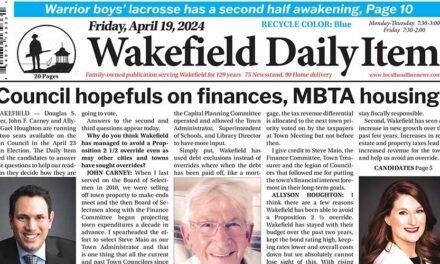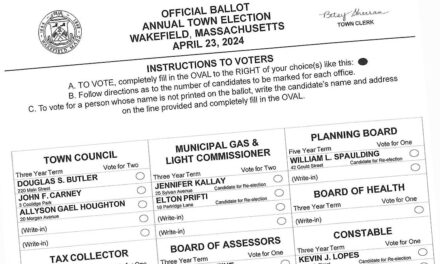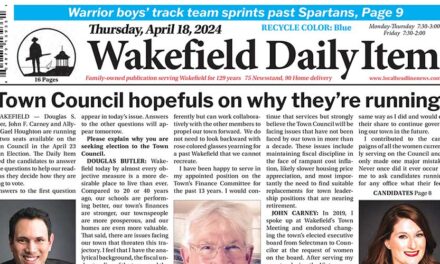Published in the July 17, 2018 edition.
By MARK SARDELLA
WAKEFIELD — Last night’s Town Council meeting became a bit unruly at times as a large crowd showed up for a discussion of four informational kiosks planned for the downtown area and near the Lake. Of particular concern to some was a proposed four-sided kiosk with an electronic component that would be located on the edge of the Lower Common, near the intersection of Church Street and Lake Avenue.
The idea of placing the kiosk at that location was to help inform the thousands of Lake-walkers of the offerings in the downtown business district in hopes of driving some of that traffic to local businesses.
The kiosks and their locations were approved by the Town Council at their May 31 meeting. The Wakefield Main Streets organization is paying for the kiosks and their installation with funding from a state grant. To design the kiosks, the Main Streets group retained the services of Favermann Design, the same firm that is working with the town on a branding and way-finding program.
Since the kiosks were approved on May 31, opposition has been gathering steam behind the scenes and on social media. Many have expressed opposition to the electronic kiosk so close to the Common and the Lake on aesthetic and safety grounds. Others felt that the town didn’t do enough to inform people of the plans so that they could weigh in.
Town Council Chairman Peter May started last night’s meeting by observing that the grant to pay for the kiosks is time-sensitive and if the town does not proceed soon, it risks losing not only the grant but future funding opportunities. (See May’s full statement separately on this page.)
The first person to speak during public participation was Bill Conley, president of the Friends of lake Quannapowitt. He asked for a delay in installing the electronic kiosk to allow time for wider input from the community. He said that FOLQ has received numerous comments from residents concerned about this kiosk.
Cheryl Webb Scott from the Wakefield Center Neighborhood Association called the Common and the Lake area “a jewel” that other communities wish they had. She said that she would like to see the Common remain “pristine.” She hoped that the board would reconsider and find a more suitable place. “It doesn’t belong there,” she said.
Judy Shea of Oak Street said that she was a 76-year resident of the town. She maintained that the kiosk would duplicate information that everyone walking the Lake has on their smartphones. She said that she hoped for a delay so that a compromise could be reached.
Maureen Howland of Common Street said that since she heard about the kiosk plan she “hasn’t been able to sleep,” calling it “a horror.” She said that she hoped that the Town Council would “come to its senses and put a stop to kiosks on the Lake.”
Bob Mailhoit, president of the Main Streets group that proposed the kiosks noted that the Town Council vote in favor of them on May 31 was unanimous. He said that his group ran this proposal through the town at every stage, including numerous meetings with many town officials.
“To change now would set a horrible precedent,” he said.
Mailhoit also corrected misinformation about the kiosk’s size. The digital kiosk would be under 10 feet tall he said, with a TV monitor on one-side with no sound.
Local real estate agent Chris Barrett said that he supported the work of the Main Streets group and that their efforts will help local businesses.
When members of the Town Council had their chance to speak, Tony Longo led off by chastising FOLQ for putting his home phone number on social media. He said that people should have contacted him via email or gotten his cell phone number form Town Hall.
Councilor Ann Santos also said that she did not appreciate the tone of some of the emails that she received on the subject of the kiosks. She also disagreed with accusations that there had been a “lack of transparency,” noting that the plans had been reported on the newspaper and elsewhere.
Councilor Paul DiNocco pointed out that the public discussions of the kiosks started in 2014 when Main Streets received the grant “and have continued for three years.”
“We were as transparent as possible,” he said. “If you didn’t hear about it you are living in a cave.” He noted that Main Streets held two public forums and was present at two Farmers Markets to talk to people about their plans.
DiNocco did concede that if it were up to him he would move the kiosk a short distance from its planned location so that it would be closer to the corner of Lake Avenue.
At this point, some in the audience began shouting, “shame on you,” accusing DiNocco of being “patronizing” in his comments.
Conley asked people to “take it down a notch” and reiterated his request for a delay so that groups like FOLQ could work with Main Streets on a possible solution.
Karen Faler of Lowell Street and an active member of FOLQ conceded that there may have been lots of meetings, “but we didn’t succeed in getting this into the public arena.”
Chairman May also asked people to use the short window of time remaining to communicate and try to come to a resolution, but he reiterated that he did not want a delay that could put the grant funding at risk.
“There will always be different opinions,” he said.
Mailhoit asked to respond to some of what had been said. He noted that even disregarding all of the previous public meetings, the kiosk plan has been out in the open at least since the Town Council approved them on May 31. But until this past Sunday, he had not heard from even one person asking to discuss the decision.
“It’s past that point now,” he said. “We’re up against it. There are only three weeks left and it took us three years to come up with the location.”
Instead of hurling insults and attacks on social media forums, Mailhoit suggested that people should have called him or DiNocco or Town Administrator Stephen P. Maio and requested a meeting to discuss the location.
Mailhoit said that after the Town Council voted unanimously on May 31 to approve final proposal, he notified the state that everything was all set and good to go.
He wondered what the state would think if it now turns out that everything wasn’t “good to go” after all.
“That’s a reflection on me,” he said, “It’s a reflection on Main Streets. It’s a reflection on the town.”
He noted that he met with and worked with Maio, DPW Director Richard Stinson and Town Planner Paul Reavis to choose the location.
“It’s the best spot,” he told the Town Council. “You voted for it. You had the information in front of you.”




